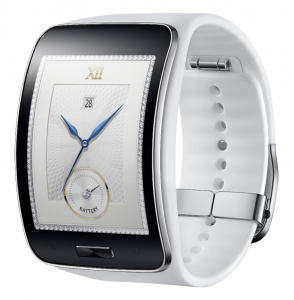Samsung’s Gear S smartwatch promises greater autonomy from your smartphone, a colorful display, and a slew of other new features. Is it enough to sell you on the need for a smartwatch? Let’s take a look.
Build and Design
With a large rectangular screen, chromed edges, and prominent all glass front, the Gear S looks less like other smartwatches and more like an iPhone had a child with a rubber wristband. But if it looks a lot like a smartphone, that’s probably because it’s not too far off from being one. Unlike other smartwatches, the Gear S isn’t solely dependent on a Bluetooth link to another device; it has a complete set of hardware inside it, including an independent cellular radio that we’ll get to in a minute.
The band is 100% rubber, which seems a little cheap considering the device’s rather hefty price tag. But it is easy to take off and replace, so if you don’t like it, there will probably be alternatives available. The body features only a single button that doubles as both power and “home,” and only a single connector on the back, a series of spring loaded pins that connect it to the charger.
A big part of this design is to help keep it water-resistant. The Gear S is rated for complete immersion in water for up to 30 minutes, and its mix of rugged glass and plastic gives it a real feeling of durability from nicks and scratches. All other interaction with the Gear S is done either through the touchscreen or the Gear app of your paired smartphone. Otherwise, the aesthetic here isn’t exactly stunning to the eye. Still, it is a very solid little device.
Display
By modern smartphone standards, the Gear S’s screen is tiny, at just 2.0 inches diagonal. But it certainly doesn’t skimp on quality for the size. At a resolution of 360 x 480, it boasts a pixel density of 300 ppi, which is more than solid for a screen this size. It’s also an OLED display, just like the panels on most of Samsung’s other devices. Per usual with those screens, this gives it an excellent contrast ratio, vibrant colors, and high energy efficiency, since it doesn’t need to light up when displaying blacks. This makes it just as great for battery life as it is for overall quality. Samsung’s built up a bit of a reputation for producing great smart device displays as of late, and the Gear S continues that trend.
Performance
It’s once you actually start to use the Gear S that you can start to see why someone would buy the thing. Under the hood, the Gear S basically has the specifications of a low-end smartphone from not that long ago: a 1 GHz processor, 512 MB of RAM, 4 GB of storage, Bluetooth, Wi-Fi, and GPS. What stands out, though, is that it has more sensors than you can shake a stick at, including a digital compass, pedometer, gyroscope, heart rate monitor, visible light, and UV light, among others. These all combine for a huge number of uses — many are the same things you can do with a smartphone, of course, along with a few tricks more suited to traditional fitness trackers, like health and exercise tracking and UV index alerts.
The Gear S can also operate autonomously even if you don’t carry your phone everywhere. While other smartwatches sync over Bluetooth, and have to stay within 30 feet of a phone, the Gear S comes equipped with its own 3G radio and data connection, allowing it to sync to your phone over the Internet instead. Thus, even when you leave your phone behind, you still effectively have it with you, allowing for sent or received calls and texts under your own number. When you get back to your phone, it will automatically reconnect over Bluetooth or Wi-Fi.
The post Samsung Gear S Review: The Price of Portability appeared first on Brighthand.com.

